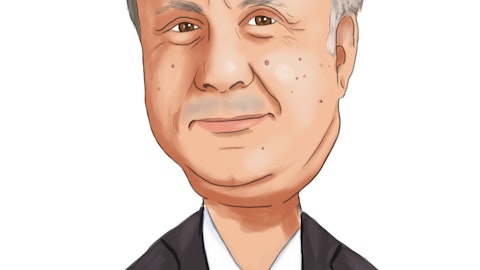Brandon Sim: Please, go ahead.
Chan Basho: As you’ll see historically, Q4 for us are usually relatively quiet. It is — we don’t necessarily have the same level of quality bonuses or any type of shared risk true-ups. And so, as you can see from our guidance, we do expect Q4 to be in line with what you’ve seen in historical years.
Adam Ron: No problem. And on the revenue guidance cut due to Medicaid redeterminations, is there any margin implications of losing enough membership that it would actually impact your revenue guidance? And would you continue that pressure to extend into 2024, both on the revenue side? And are you building anything on margins?
Chan Basho: So, for every three Medicaid members that through redetermination are leaving the organization. One is reenrolling, is what we’re seeing in an exchange product. And so, in terms of margin, the net margin impact is quite minimal, I’d say it’s on an annualized basis, probably $1 million to $1.5 million. In terms of revenue, as you saw from our decrease in guidance, that is probably more of an impact where on an annualized basis, it’s in the $5 million to $10 million range for 2024.
Adam Ron: That’s helpful. And then the APC share buyback. Was that purely motivated by the tax implications that you mentioned? Or did they want to sell? Or did you go to them? I’m just like curious what drove that and if the plan is to buyback all the shares and if that’s necessary to reach your tax rate targets?
Brandon Sim: Adam. I’ll take this question around the APC share buyback, which was around just approximately $100 million of value. There are a couple of reasons. The first is that, as you know, from the last quarter, we were experiencing elevated levels of taxation due to essentially filing separately and not being a consolidated tax entity. Part of the reason is to, as Chan mentioned earlier, to solve for that. But I think regardless of that, we are very optimistic and I think that there is a great amount of potential ahead in terms of the pipeline opportunities we’ve been signing, the way we’ve been deploying our capital, and the continued strength that we’re seeing in our clinical models. And we felt that this was a good time to exercise that $100 million buyback.
Adam Ron: I appreciate the questions. My last one would be, when you guided for the peer, you gave basically flat EBITDA guidance at the midpoint, with the rationale being that there was like Medicaid redetermination headwinds and reinvestments into growth. And so, for next year? Are there any major moving pieces that we should consider, I guess, Medicaid redeterminations will continue? The RKK license should be somewhat lifting revenue. It sounds like on the MA side, at least, there are some deals closing. And so other than those, are there any moving pieces we should be considering?
Brandon Sim: Yes, of course. So, I think business continues to be quite strong. We don’t anticipate a huge variation in medical cost ratio next year either. Of course, we haven’t put out official 2024 guidance, so we will certainly update the market when that happens. But given the amount of new partnerships that we’ve already signed, five for the year, a few in the pipeline and the acquisition of CFC and continued seeing provider growth, we’re quite optimistic that EBITDA will continue to grow at a healthy clip and perhaps even more at a higher rate than it did this year relative to last. As you remember, you may remember, Adam, this year, there was a bit of a harsh comp in terms of the onetime next-gen ACO payment in Q3 of last year. And the rest of the business has grown tremendously, which will continue to happen and that comp is not expected to be there for the next year.
Operator: And we’ll take our next question from David Larsen from BTIG. Please go ahead, David.
David Larsen : Relative to our model, the gross profit really beat our estimate. Can you maybe just talk a little bit more about your — the utilization you’re seeing, the cost of services. It sounds like there was an ACO true-up. What does that mean? Does that mean that the actual claims cost came in lower than expected? Or did you get some sort of an incentive payment from CMS in the quarter? Just any more color there would be very helpful. And more importantly, do you expect that trend to continue into next year? Thank you.
Chan Basho: David, great to hear from you. Yes. Thanks so much for the question. So, in terms of our MCR, I’ll start with ACO. What we’re seeing on ACO is that we have more data really to evaluate the performance of the program in 2023. And we were able to true up where we were coming in, in costs for the first three months of the year relative to where we were in Q1 and Q2, which was really breakeven. In terms of our overall Managed Care business, as we’ve mentioned before, we — due to our unique clinical model as well that really provides access and quality, and we’re continuing to see stable institutional metrics. Both of those put together have really led to that strong performance. Lastly, also, would want to mention we saw strong sweeps payments in Q3 associated with our Medicare Advantage members.
David Larsen : Okay. Great. That’s very helpful. And then as some of these acquisitions and partnerships roll into the Care Partners division of the business, I’m assuming that since they were already Care Enablement clients. You have very good visibility into the membership, their utilization trends, the premium dollars, the margins on each member. So, it’s not like there’s going to be an increase in costs as you try to stabilize these newer members like we see in some other business models, they’re already sort of well-known and well-managed to you. Is that correct?
Brandon Sim: David, Brandon here. Thanks for the question. You’re absolutely correct. For the for the clinics, for example, that we acquired the five clinics that are moving into our Care Delivery segment, there will be some minor implementation integration costs, but very, very minor, but we expect those to be accretive day one, because of the length of the relationship that we’ve developed over time in the Care Enablement segment. For the larger groups, CFC, for example, in Advantage Health Network, who are already Care Enablement clients, we absolutely expect to also see that synergy. Those providers are all already onboarded onto the technology platform. There will not be additional incremental cost or time associated with getting them onto the platform, and we have a very good line of sight into all those metrics that you mentioned, and how we can best take care or assist them, empower them to take care of their patient panels.
And so, we view that as a very — we view that as part of the synergy of having all 3 business segments, and it gives us kind of a much more shallow J-curve, so to speak.
David Larsen : Okay. Great. That’s very helpful. And then do you have any initial thoughts on 2024, we’ll call it like Medicare premiums or reimbursement that you expect to see from the docs, from CMS. There’s been a lot of noise around RADV audits, lower premium increases in ’24 relative to the increase that was seen in 2023. And there’s a lot of adjustments that are going on in terms of like risk stratification. Just any thoughts or color there? Do you expect an increase in dollars coming from CMS on a per-member basis in ’24 relative to ’23?
Brandon Sim: Of course, there has been a lot of noise, of course, lately around reimbursement rates, RADV 28, and other reimbursement items, stars as well. I think overall, we are navigating through this in a couple of ways. One, we continue to use our scaled platform to ensure that we have solid contracts with our payer partners, where I’m helping to manage their quality, stars, and risk adjustment better than others, relatively speaking. And we think there’s a lot of value we’re providing to payers such that we are more than “paying off” kind of the types of contracts that we have with payers. In addition, in terms of RADV, as we’ve spoken about before, we don’t think we’ll be impacted significantly, if at all. We’ve — our average risk score is still fairly low across our Medicare Advantage population, around 1.0, which is the national average.




